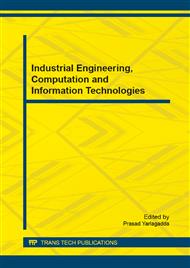[1]
Andreas Poullikkas, Implementation of distributed generation technologies in isolated power systems,Electricity Authority of Cyprus, 2006,23(7): 158-160.
Google Scholar
[2]
Jarmo Soderman, Frank Pettersson, Structural and operational optimisation of distributed energy systems, Applied Thermal Engineering, 2005, 18(9): 200-205.
Google Scholar
[3]
Hongwei Li, Razi Nalim, Thermal-economic optimization of a distributed multi-generation energy system—A case study of Beijing, Applied Thermal Engineering, 2005, (6): 130-133.
DOI: 10.1016/j.applthermaleng.2005.09.005
Google Scholar
[4]
P.A. Pilavachi. Power generation with gas turbine systems and combined heat and power[J]. Applied Thermal Engineering, 2000, (20): 1421-1429.
DOI: 10.1016/s1359-4311(00)00016-8
Google Scholar
[5]
H. Lund.E. Munster. Modelling of energy systems with high percentage of CHP and wind power[J]. Renewable Energy, 2003(28): 7179-7193.
DOI: 10.1016/s0960-1481(03)00125-3
Google Scholar
[6]
Alexandre Salem Szklo, jeferson Borghetti Soares, Mauricio Tiomno Tolmasquim. Energy consumption indicators and CHP technical potential in the Brazilian hospital sector[J]. Energy Conversion and Management, 2004 (40): 2075-(2091).
DOI: 10.1016/j.enconman.2003.10.019
Google Scholar
[7]
Thomas G. Bourgeois, Bruce Hedman, Fred Zalcman. Creating markerts for combined heat and power and clean distributed generation in New York State[J]. Environmental Pollution, 2003 (123): 451-462.
DOI: 10.1016/s0269-7491(03)00016-2
Google Scholar
[8]
Yongli Wang. Theory and Application Research of Regional Client Energy Comprehensive Demand-Side Management[D], North China Electric Power University, doctoral dissertation, Beijing, (2010).
Google Scholar
[9]
Thomas BrucKner, Robbie Morrison, Tobias Wittmann, Public policy modeling of distributed energy, technologies: strategies, attributes, and challenges [J]. Energy Conversion and Management, 2005, 13(4): 100-107.
DOI: 10.1016/j.ecolecon.2004.12.032
Google Scholar
[10]
Weiguo Shi, Pin Song, Chuanquan Liu. Power supply reliability of distribution network including distributed generation[J]. East China Electric Power, 2007, 35(7): 37-41.
Google Scholar
[11]
Mahnud F F. An Analytical Mefliod to Consider DG Impacts on Distribution System Reliability [J]. IEEE Transnission and Distribution Conferencc & Exhibition (2005).
Google Scholar
[12]
Fabrioglu M, Alvarado F L. Using utility information to calibrate customer demand mangagement behavior models. IEEE Transcation on Power System, 2001, 16(2): 317-322.
DOI: 10.1109/59.918305
Google Scholar
[13]
Kirschen D. Demand-side view of electricity market. IEEE Transcation on Power Systems, 2003, 18(2): 520-527.
DOI: 10.1109/tpwrs.2003.810692
Google Scholar
[14]
Sharma, D. Parameswara etc. Analytical search of problems and prospects of power sector through Delphi study: case study of Kerala State, India[J]. Energy Policy, 2003, 31(9): 1245-1255.
DOI: 10.1016/s0301-4215(02)00185-4
Google Scholar
[15]
Fahrioglu M, Alvarado F L. Designing incentive compatible contracts for effective demand management. IEEE Transcation on Power Systems, 2000, 15(4): 1255-1260.
DOI: 10.1109/59.898098
Google Scholar


